国际商法 WTO介绍
国际商法:WTO组织程序

一、关于WTO的宗旨问题: 关于WTO的宗旨问题: WTO的宗旨问题
1、GATT的宗旨: 、 的宗旨: 的宗旨
最高的目标是什么? 最高的目标是什么?
“通过促进国际贸易的发展 , 稳定生产与就业 , 鼓 通过促进国际贸易的发展, 稳定生产与就业, 通过促进国际贸易的发展 励落后地区经济的发展, 励落后地区经济的发展,为世界经济发展和生活水平的 提高做出贡献” 提高做出贡献”。
正式的决策机制
正式的决策机制:“协商一致”、投票和“反向协商一致” “协商一致”是WTO的骄傲,它的决策由所有成员国的代表、 大使或部长们通过“协商一致”原则做出,每个成员国都有投票 否决权,就此而言,WTO比IMF(International Monetary Fund)和 WB(World Bank)更加民主。 如果某一决定未能达成协商一致,则以投票决定。投票决策 的方式主要有四种:简单多数、三分之二、四分之三以及全体成 员方同意。但是,如果贸易大国反对,即使通过投票达成协议, 该协议不被贸易大国执行,其影响和作用在国际贸易中没有任何 实质作用和意义,反而威胁到WTO的地位和权威。因此,各成员 国都尽量避免出现这种情况,正式的投票程序常常被“协商一致” 取代。 此外,WTO还有“反向协商一致”的决策方式,即所有与会 成员以“协商一致”的方式做出否定的表示,只要无人明确表示 否决就赞成,任何不出席会议、出席会议不发言、发言只作一般 评论、弃权等均不构成对决定的否决。这种决策方式主要用于争 端解决机制。
WTO组织机构、表决程序
世界贸易组织(以下简称 “世贸组织”)正式成立,自 此取代关贸总协定,确立了 多边贸易体制规则。它不仅 从法律上具备了健全的国际 法人资格,而且协调管理的 领域拓宽,规则加严。世贸 组织通过贸易政策审议机制、 争端解决机制、补贴纪律、 可持续发展、服务贸易自由 化、知识产权保护和贸易政 策、法规的透明度等基本原 则,使其对世界经济贸易的 发展产生重大影响。就世贸 组织现有的职能和协调范围 而言,它已成为名副其实的 “经济联合国”(Economic UN)。
第一讲 WTO的基本知识
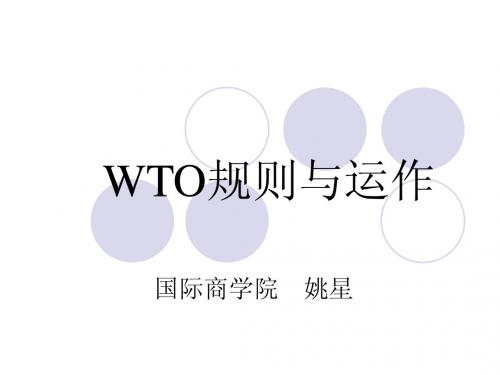
WTO的目标是:
1 提高生活水平; 2 保证充分就业和实际收入与有效需求的大幅度稳定增长; 3 扩大商品与服务的生产和贸易; 4 允许根据可持续发展目标合理地利用世界资源; 5 与各国不同的经济发展水平所决定的各自需求与关注的问 题相一致寻求保护和维持环境,并改进保护和维持环境的 方法; 6 保证发展中国家,特别是它们中间的最不发达国家在国际 贸易增长中获得与他们的经济发展需要相适应的份额。
WTO《关于建立世界贸易组织的协定》第2条规定: WTO provides both the common institutional framework and legal instruments of the conduct of trade relations among its Members. WTO通过所达成的协定为成员国之间处理贸易关系 提供共同的制度框架和WT0协定文件中所规定的法
括:可以订立与其职能相关或履行职能所必需的合同、协议;
可以拥有动产和不动产;可以提起诉讼,并以自己的名义享受 权利、承担义务;可以享有各成员方赋予它的特权和豁免等。 当然,它享有的权利来自全体成员方的授权,其权利的行使应 限定在一定的范围内,一般来说,其权利和活动范围不能超出
各成员方通过协议规定的内容。
需待别提出的是环境与贸易协调发展是WTO基本目 标之一。 WTO《关税与贸易总协定1994》(General agreement on tariffs and trade l994,简称 《GATT1994》)第20条(“一般例外’’)中规定: subject to the requirement that such measures are not applied in a manner which would constitute a means of arbitrary or unjustifiable discrimination between countries where the same conditions prevail, or a disguised restriction on international trade, nothing in this agreement shall be construed to prevent the adoption or enforcement by any contracting party of measures:
世界贸易组织(WTO法律专题)内容提要.

世界贸易组织(WTO法律专题)内容提要.世界贸易组织( WTO法律专题)内容提要[第一篇] 第一章国际贸易理论与WTO的产生第一节国际贸易理论学说概述一、重商主义学说产生于15世纪,盛行于16-17世纪上半时,代表人物——海尔斯(英)、博丹(法)、塞拉(法)、托马斯·孟(英)。
认为发展国际贸易是获取财富的唯一途径,主张国家干预经济活动,实行贸易顺差。
二、绝对优势理论学说产生于18世纪,为英国古典政治经济学创立者亚当·斯密所倡导。
该学说极力提倡自由贸易,反对重商主义提出的贸易保护可以增加一国财富的观点。
三、比较优势理论学说产生于18世纪,英国大卫·李嘉图创立,经过不断完善和发展,成为国际自由贸易理论的核心理论。
该学说以成本比较法为基础,主张自由贸易,国际分工。
四、国际贸易保护理论学说产生于18世纪末,美国汉密尔顿、德国李斯所创立。
该学说主张处于发展早期的国家,应通过保护性关税和配额来保护国内有关产业。
第二节 GATT的产生与发展一、GATT产生的历史背景19世纪末20世纪初,资本主义进入垄断阶段,逐渐放弃自由贸易政策,实行贸易保护主义,提高关税税率,从而使国际贸易趋于萎缩。
二、GATT的产生1947年10月23日,23个国家在瑞士日内瓦签署了《关税与贸易总协定》(GATT),1948年1月1日开始实施,但一直以临时适用的多边协定形式存在,到1994年底终止,共运作了47年,有缔约方128个。
三、GATT的基础与宗旨基础:实行以市场经济为基础的自由贸易体制。
宗旨:提高各缔约方人民的生活水平,保证充分就业,保证实际收入和有效需求的巨大持续增长,扩大世界资源的充分利用,发展商品的生产与交换。
为了实现这一宗旨,各缔约方必须大幅度削减关税和其他贸易障碍,取消国际贸易中的歧视待遇。
四、GATT的历次多边贸易谈判GATT成立以来,共主持了八轮全球多边贸易谈判(一轮称为一个“回合”)。
wto世界贸易组织介绍演讲ppt

WTO
世界贸易组织
13法二班
WTO成立与发展简介:
1994年4月15日,在摩洛哥的马拉喀 什市举行的关贸总协定乌拉圭回合部长会 议决定成立更具全球性的世界贸易组织 , 以取代成立于1947年的关贸总协定。世界 贸易组织是当代最重要的国际经济组织之 一。是负责监督成员经济体之间各种贸易 协议得到执行的一个国际组织,前身是 1948年开始实施的 关税及贸易总协定的 秘书处。世贸总部位于瑞士日内瓦,现任 能
任命世贸组织总干事并制定有关规则; 对世贸组织协定和多边贸易协定做出解 释;审议其成员对贸易协定提出修改的 动议;决定是否接纳申请加入世贸组织 的国家或地区为世贸组织成员等。
处理特定的贸易及其他有关事宜。 已设立贸易与发展委员会;国际收支
限制委员会;预算、财务与行政委员
会;贸易与环境委员会等10多个专门 委员会。
验。 4、 加入WTO,意味着中国从今以后就可以参与制定国 际经济贸易规则了, 这样可以提高中国在国际社会的地位,
增加发言权
1.彻底转变行政理念 体制创新的 前提是理念创新。 2.通过机构改革,构建精干、高 效、协调、廉价、廉洁的政府机 构体系。 3.政府职能的转变和定位。 4.建立全新的公务员任用制度, 使政府工作人员职业化 以法律法 规的形式建立公务员考试、选拔、 任用、评价、晋升、辞退制度, 引入优胜劣汰机制。
中国加入WTO的“一国四席”问题
一国四席
台湾
中国
WTO
澳门
香港
“一国四席”产生原因
1、 WTO的成员资格要求 《WTO协定》第12条第1款规定了纳入成员资格和程序: “任何国家或在处理其对外商业关系及本协定和多边贸易协 定规定的其他事项中享有充分自治权的单独关税区,可按它与 WTO议定的条件加入本协定。”可见,WTO成员资格可以是 主权国家和单独关税区,而不仅仅是主权国家。 2、 中国的特殊国情 由于WTO成员资格向主权国家和非主权的单独关税区开放, 一个主权国家与隶属于该主权国家的一个或数个单独关税区 分别加入WTO,或者在一个主权国家未加入WTO的情况下, 隶属于该主权国家的单个关税区分别加入WTO,都可能形成 WTO体制下的“一国多席”局面。
国际经济法中wto的名词解释

国际经济法中wto的名词解释导言国际经济法是研究国际经济关系的法律学科,涵盖了包括国际贸易法在内的多个方面。
而在国际贸易法中,世界贸易组织(World Trade Organization, WTO)是最重要的国际组织之一。
本文旨在解释一些国际经济法中与WTO相关的重要名词,进一步了解WTO在国际经济关系中的作用和意义。
一、世界贸易组织(WTO)世界贸易组织是由贸易协定履行机构演变而来的国际组织。
其宗旨是促进全球贸易的自由化和公平性,通过制定贸易规则、解决贸易争端和促进贸易谈判等方式实现这一目标。
WTO的成立于1995年,取代了多哈回合之前的关税和贸易总协定(General Agreement on Tariffs and Trade, GATT)。
目前,全球大部分国家都是WTO的成员。
二、最惠国待遇(Most-Favored-Nation, MFN)最惠国待遇是WTO贸易规则的基本原则之一。
它要求WTO成员国在对待其他成员国时不得区别对待,除非存在与非成员国有利且不歧视性的特殊安排。
也就是说,如果一个WTO成员国给予另一个成员国某种优惠待遇,那么该优惠待遇应适用于所有其他成员国,避免贸易壁垒。
三、关税与非关税壁垒(Tariffs and Non-Tariff Barriers)关税是指国家对进口商品征收的税收,是一种常见的贸易壁垒形式。
WTO通过多哈回合谈判和其他贸易谈判,逐步降低和消除了许多国家的关税水平,以促进自由贸易。
非关税壁垒则指除关税以外的其它措施,如配额限制、进口许可证、技术壁垒、反倾销措施等。
WTO通过规则制定和争端解决机制,限制了非关税壁垒的使用,并促使成员国逐步消除这些壁垒。
四、贸易争端解决机制(Dispute Settlement Mechanism)贸易争端解决机制是WTO的核心机构之一,用于解决成员国之间的贸易争端。
当某个成员国认为其他成员国采取了违反WTO规则的贸易措施时,可以向WTO提起贸易争端。
wto介绍
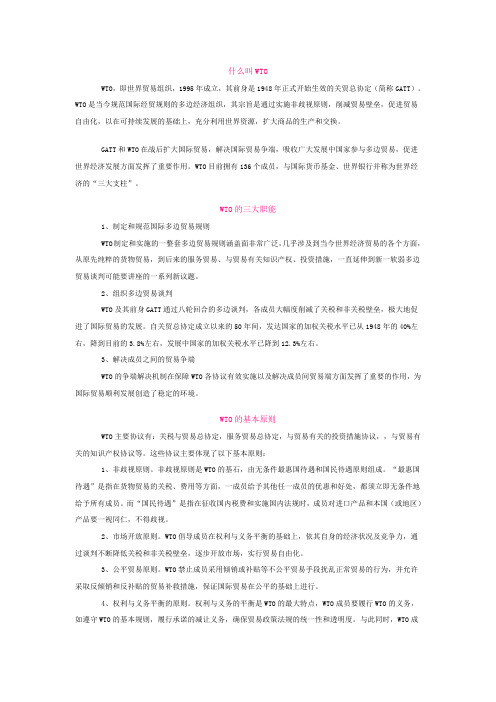
什么叫WTOWTO,即世界贸易组织,1995年成立,其前身是1948年正式开始生效的关贸总协定(简称GATT)。
WTO 是当今规范国际经贸规则的多边经济组织,其宗旨是通过实施非歧视原则,削减贸易壁垒,促进贸易自由化,以在可持续发展的基础上,充分利用世界资源,扩大商品的生产和交换。
GATT和WTO在战后扩大国际贸易,解决国际贸易争端,吸收广大发展中国家参与多边贸易,促进世界经济发展方面发挥了重要作用。
WTO目前拥有136个成员,与国际货币基金、世界银行并称为世界经济的“三大支柱”。
WTO的三大职能1、制定和规范国际多边贸易规则WTO制定和实施的一整套多边贸易规则涵盖面非常广泛,几乎涉及到当今世界经济贸易的各个方面,从原先纯粹的货物贸易,到后来的服务贸易、与贸易有关知识产权、投资措施,一直延伸到新一软弱多边贸易谈判可能要讲座的一系列新议题。
2、组织多边贸易谈判WTO及其前身GATT通过八轮回合的多边谈判,各成员大幅度削减了关税和非关税壁垒,极大地促进了国际贸易的发展。
自关贸总协定成立以来的50年间,发达国家的加权关税水平已从1948年的40%左右,降到目前的3.8%左右,发展中国家的加权关税水平已降到12.3%左右。
3、解决成员之间的贸易争端WTO的争端解决机制在保障WTO各协议有效实施以及解决成员间贸易端方面发挥了重要的作用,为国际贸易顺利发展创造了稳定的环境。
WTO的基本原则WTO主要协议有:关税与贸易总协定,服务贸易总协定,与贸易有关的投资措施协议,,与贸易有关的知识产权协议等。
这些协议主要体现了以下基本原则:1、非歧视原则。
非歧视原则是WTO的基石,由无条件最惠国待遇和国民待遇原则组成。
“最惠国待遇”是指在货物贸易的关税、费用等方面,一成员给予其他任一成员的优惠和好处,都须立即无条件地给予所有成员。
而“国民待遇”是指在征收国内税费和实施国内法规时,成员对进口产品和本国(或地区)产品要一视同仁,不得歧视。
WTO概述
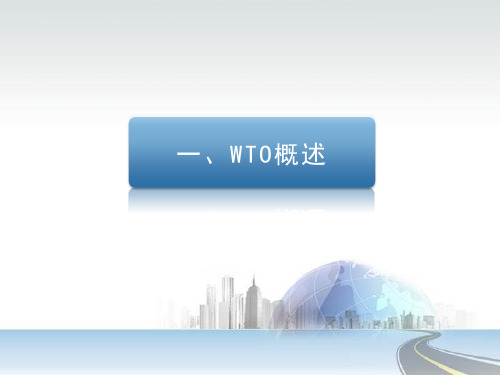
每个成员方给予WTO的官员、成员方代表的特权与豁免等同于联
合国大会于1947年11月21日通过的特殊机构的特权与豁免公约所 规定的特权与豁免权。
(六)GATT和WTO多边贸易谈判
GATT
WTO
1
2
34
5
67
8
9
降低关税水平 消减非关税壁垒 完善多边贸易体制
多哈回合
(七)WTO的组织结构
世界贸易组织机构设置图
二、WTO协议及其基本原则
二、WTO协议及其基本原则
(一)WTO的法律框架 (二)乌拉圭谈判的主要议题和WTO规则 (三)WTO的基本原则
(一)WTO的法律框架
包括乌拉圭回合谈判达成的各项世
界贸易组织协议
继承了关贸总协定的一些协议 新达成的协议,包括21个领域,共
(三)途径
贸易自由化
通过互惠安排,降低关税水平和削 减非关税壁垒,在国际贸易中消除 歧视待遇。
(四)职能
职能
促进WTO贸易协议的执行、管理和运作,并为其提供一个组织基础。 为成员提供进行谈判的场所,同时是协助执行谈判成果的机构。 管理争端解决机制。 管理贸易政策的审议机制。 为达到全球经济政策的一致性,WTO以适当的方式与国际货币基金
WTO
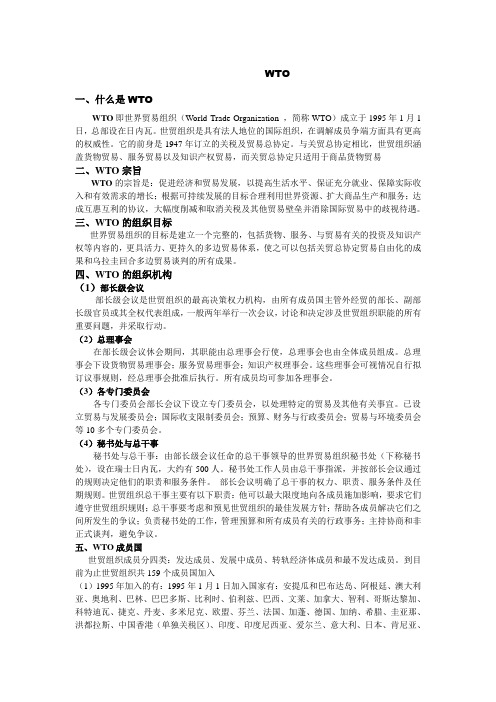
WTO一、什么是WTOWTO即世界贸易组织(World Trade Organization ,简称WTO)成立于1995年1月1日,总部设在日内瓦。
世贸组织是具有法人地位的国际组织,在调解成员争端方面具有更高的权威性。
它的前身是1947年订立的关税及贸易总协定。
与关贸总协定相比,世贸组织涵盖货物贸易、服务贸易以及知识产权贸易,而关贸总协定只适用于商品货物贸易二、WTO宗旨WTO的宗旨是:促进经济和贸易发展,以提高生活水平、保证充分就业、保障实际收入和有效需求的增长;根据可持续发展的目标合理利用世界资源、扩大商品生产和服务;达成互惠互利的协议,大幅度削减和取消关税及其他贸易壁垒并消除国际贸易中的歧视待遇。
三、WTO的组织目标世界贸易组织的目标是建立一个完整的,包括货物、服务、与贸易有关的投资及知识产权等内容的,更具活力、更持久的多边贸易体系,使之可以包括关贸总协定贸易自由化的成果和乌拉圭回合多边贸易谈判的所有成果。
四、WTO的组织机构(1)部长级会议部长级会议是世贸组织的最高决策权力机构,由所有成员国主管外经贸的部长、副部长级官员或其全权代表组成,一般两年举行一次会议,讨论和决定涉及世贸组织职能的所有重要问题,并采取行动。
(2)总理事会在部长级会议休会期间,其职能由总理事会行使,总理事会也由全体成员组成。
总理事会下设货物贸易理事会;服务贸易理事会;知识产权理事会。
这些理事会可视情况自行拟订议事规则,经总理事会批准后执行。
所有成员均可参加各理事会。
(3)各专门委员会各专门委员会部长会议下设立专门委员会,以处理特定的贸易及其他有关事宜。
已设立贸易与发展委员会;国际收支限制委员会;预算、财务与行政委员会;贸易与环境委员会等10多个专门委员会。
(4)秘书处与总干事秘书处与总干事:由部长级会议任命的总干事领导的世界贸易组织秘书处(下称秘书处),设在瑞士日内瓦,大约有500人。
秘书处工作人员由总干事指派,并按部长会议通过的规则决定他们的职责和服务条件。
国际商法第二章WTO法律制度第三节反补贴规则

国际商法第二章WTO法律制度第三节反补贴规则反补贴规则是WTO法律体系中的重要组成部分,旨在解决成员国之间不公平的贸易补贴问题。
本文将对WTO反补贴规则进行详细介绍。
WTO反补贴规则的目的是防止成员国通过补贴措施来干预国际贸易,保护国际市场的公平竞争环境。
根据WTO的《反补贴协定》,补贴被定义为“指除关税外的政府或公共机构提供给生产者或出口商的直接或间接经济利益”,反补贴规则适用于所有形式的补贴。
首先,WTO反补贴规则要求成员国通过成立“反补贴调查”机构来监测和调查补贴行为。
当一个成员国认为其他成员国的产品受到了不公平的补贴影响时,可以向WTO提交诉讼,并要求成立反补贴调查机构。
通过调查,这个机构将对补贴的性质、规模和对国际市场的影响进行评估,并做出裁决来修正不公平的补贴行为。
其次,WTO反补贴规则规定了成员国可以采取的反补贴措施。
一旦确认存在不公平的补贴行为,受影响的国家可以采取一系列的反补贴措施来应对,例如征收反补贴关税或实施数量限制。
这些措施旨在抵消补贴给予国的不公平竞争优势,并保护本国产业免受损害。
此外,反补贴规则还规定了调查程序的透明度和公正性要求。
根据WTO的规定,反补贴调查程序应确保受调查方的合法权益得到保护,并提供充分的听证程序和申诉程序。
同时,调查结果和裁决应向所有成员国公开,以确保程序的透明和公正。
最后,WTO还设立了补贴监管机构,负责监督和执行反补贴规则。
这个机构将定期审查世界各国的补贴政策并发布报告,促使各成员国遵守规则并改善其补贴政策。
此外,补贴监管机构还提供技术援助和培训,帮助发展中国家更好地理解和应用反补贴规则。
总之,WTO反补贴规则的制定和实施对于维护国际贸易的公平和公正至关重要。
通过调查和裁决机制以及反补贴措施的采取,这一规则有效地限制了成员国之间不公平的补贴行为,并促进了国际市场的公平竞争环境。
同时,反补贴规则也为发展中国家提供了技术援助和培训,帮助他们更好地理解和应用这一规则。
WTO介绍清晰版,含机构设置图

WTO介绍清晰版世界贸易组织,英文名称World Trade Organization ,缩写为WTO,简称世贸组织。
是世界上唯一处理国与国之间贸易规则的国际组织,它成立于1995年1月1日,总部设在瑞士日内瓦。
世界贸易组织是当代最重要的国际经济组织之一,拥有162个成员,成员贸易总额达到全球的98%,有“经济联合国”之称。
我国于2001年12月11日正式加入WTO。
WTO的历史建立世贸组织的设想是在1944年7月举行的布雷顿森林会议上提出的,当时设想在成立世界银行和国际货币基金组织的同时,成立一个国际性贸易组织,从而使它们成为二次大战后左右世界经济的“货币-金融-贸易”三位一体的机构。
1947年联合国贸易及就业会议签署的《哈瓦那宪章》同意成立世贸组织,后来由于美国的反对,世贸组织不能成立。
同年,美国发起拟订了关贸总协定,作为推行贸易自由化的临时契约。
1986年关贸总协定乌拉圭回合谈判启动后,欧共体和加拿大于1990年分别正式提出成立世贸组织的议案。
1994年4月在摩洛哥马拉喀什举行的关贸总协定部长级会议才正式决定成立世贸组织, 订立了《建立世界贸易组织协定。
1995年1月1日,世界贸易组织成立,“关贸总协定”与世界贸易组织并存1年。
1996年1月1日,它正式取代关贸总协定临时机构。
关贸总协定于1948年开始临时实施一直到1995年WTO成立,一共存在了47年。
与关贸总协定相比,世贸组织涵盖货物贸易、服务贸易以及知识产权贸易,而关贸总协定只适用于商品货物贸易。
世贸组织是具有法人地位的国际组织,在调解成员争端方面具有更高的权威性。
世贸组织与国际货币基金组织(IMF)、世界银行(WB)一起被称为世界经济发展的三大支柱。
在关贸总协定47年的历程中,共举行了8轮回合的多边贸易谈判,取得了一系列的重大成果。
●关税与贸易总协定前七轮关税谈判:其中第五轮称为“狄龙回合”,第六轮称为“肯尼迪回合”,第七轮称为“东京回合”。
国际商法第二章WTO法律制度第三节反补贴规则
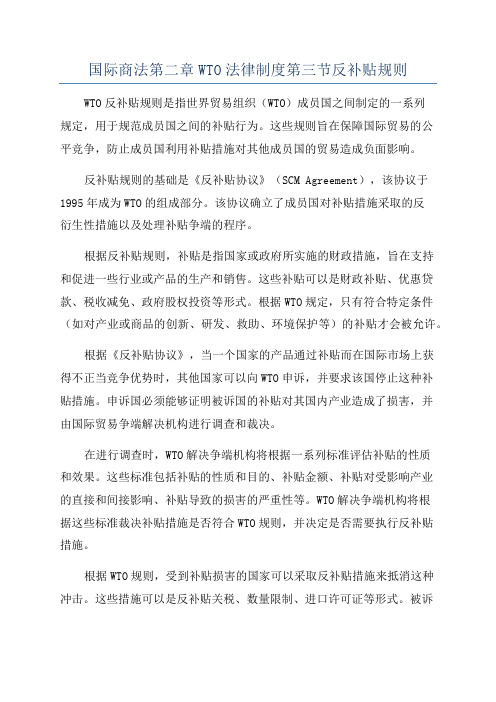
国际商法第二章WTO法律制度第三节反补贴规则WTO反补贴规则是指世界贸易组织(WTO)成员国之间制定的一系列规定,用于规范成员国之间的补贴行为。
这些规则旨在保障国际贸易的公平竞争,防止成员国利用补贴措施对其他成员国的贸易造成负面影响。
反补贴规则的基础是《反补贴协议》(SCM Agreement),该协议于1995年成为WTO的组成部分。
该协议确立了成员国对补贴措施采取的反衍生性措施以及处理补贴争端的程序。
根据反补贴规则,补贴是指国家或政府所实施的财政措施,旨在支持和促进一些行业或产品的生产和销售。
这些补贴可以是财政补贴、优惠贷款、税收减免、政府股权投资等形式。
根据WTO规定,只有符合特定条件(如对产业或商品的创新、研发、救助、环境保护等)的补贴才会被允许。
根据《反补贴协议》,当一个国家的产品通过补贴而在国际市场上获得不正当竞争优势时,其他国家可以向WTO申诉,并要求该国停止这种补贴措施。
申诉国必须能够证明被诉国的补贴对其国内产业造成了损害,并由国际贸易争端解决机构进行调查和裁决。
在进行调查时,WTO解决争端机构将根据一系列标准评估补贴的性质和效果。
这些标准包括补贴的性质和目的、补贴金额、补贴对受影响产业的直接和间接影响、补贴导致的损害的严重性等。
WTO解决争端机构将根据这些标准裁决补贴措施是否符合WTO规则,并决定是否需要执行反补贴措施。
根据WTO规则,受到补贴损害的国家可以采取反补贴措施来抵消这种冲击。
这些措施可以是反补贴关税、数量限制、进口许可证等形式。
被诉国可以选择停止补贴措施或通过改变措施使其符合WTO规则,以避免受到反补贴措施的影响。
反补贴规则的实施对于维护国际贸易的公平竞争非常重要。
它旨在防止成员国以补贴形式打破市场规则,扭曲国际贸易的平衡。
然而,补贴政策在一定程度上也是成员国维护自身经济利益的手段。
因此,在权衡国家经济利益和国际贸易公平之间需要找到平衡点,确保反补贴规则的公正性和有效性。
国经法第六章(wto法律制度)
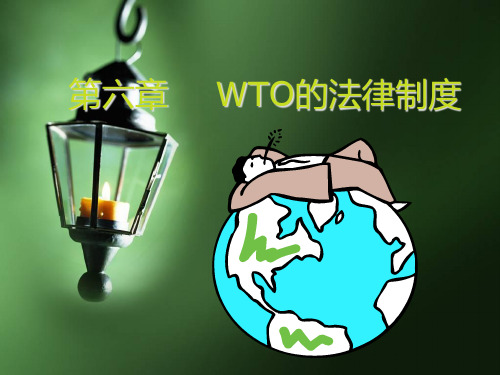
(3)内容
GATT中的国民待遇原则
GATT第3条是集中体现国民待遇的条款。GATT关于关贸 总协定体制适用国民待遇的范围较小,仅适用于货物贸易, 即适用于对进口商品的国内税收和政府对进口商品的法规、 规章等管理措施方面。根据该条第2款的规定,每一成员对 来自任何一个其他成员的进口商品所直接或间接征收的国 内税或其他国内收费均不得高于其本国的同类产品。第4款 则规定,在进口商品从通过海关进入进口方境内至该商品 最终被消费期间经过的销售、推销、购买、运输、分配或 使用的政府法令、条例和规章方面,所享受的待遇应不低 于相同的国内商品所享受的待遇。
• 非歧视原则的体现:国民待遇原则和最惠国待遇 原则
外国(人)=本国(人) 外国(人)=外国(人)
贸易只有在非歧视的基础上才能保证公平和自由 当然非歧视也不是绝对的,也存在着例外
1、最惠国待遇原则
• (1)含义: • 一成员将在货物贸易、服务贸易和知识产权领域
给予任何其他成员的优惠待遇,立即和无条件地 给予其他各成员方 • (2)特点: • 普遍性、自动性、相互性、同一性
• (5)争端解决制度不同
• WTO的争端解决机制统一并有较强约束力; GATT的争端解决机制分散且约束力弱
(三)WTO与中国
• 1986、7、10“复关”申请 • 1995、10改“复关”谈判为“入世”谈判 • 2001、12、11正式成为WTO成员 • 中国加入WTO以中国的发展中国家地位为前提 • 中国在WTO中的权利义务由两部分构成:WTO多
• 贸易措施:包括法律、法规、政策、有影响的司法 判决或行政裁定、对外签订的相关协议等。
• 2、审议频率:根据成员在世界贸易中所占的份额 决定审议的频率
• 3、审议结果:无论是受审成员自己的报告,还是 秘书处的报告,都不具有约束力
国际贸易中适用的法律与惯例

国际贸易中适用的法律与惯例国际贸易中适用的法律与惯例一、国际贸易法律国际贸易法律是各国政府为了规范国际贸易活动而制定的法律体系。
以下是国际贸易中常见的法律:1. 世界贸易组织(WTO)法律:WTO是全球范围内协调和规范国际贸易的组织。
它设立了一系列的规则,如减少贸易壁垒、非歧视待遇等,以促进自由和公平的国际贸易。
2. 国际商法:国际商法是指适用于交叉国家商业合同的法律规定。
包括国际销售合同、运输合同、知识产权等方面的法律。
3. 国际货物运输法:涵盖国际海运、航空运输和陆路运输等方面的法律。
其中最为重要的是联合国海洋法公约(UNCLOS),它规定了海洋领土的界限、船舶和货物的权益等。
二、国际贸易惯例国际贸易惯例是国际贸易各参与方在交易中普遍遵循的行为准则,虽然它们没有法律约束力,但对于国际贸易的稳定和发展具有重要作用。
以下是国际贸易中常见的惯例:1. 国际商会(ICC)惯例:国际商会发布了一系列的国际商业惯例,如国际商业术语解释规则(INCOTERMS),用于定义买卖方在交货、费用和风险方面的责任。
2. 国际贸易支付惯例:国际贸易支付涉及到各类支付方式,如信用证、托收等。
国际商会发布了相应的国际贸易支付惯例,旨在为双方提供安全和可靠的支付方式。
3. 国际仲裁惯例:在国际贸易中,当合同纠纷发生时,经常采用仲裁解决争议。
国际仲裁惯例主要由国际商会和联合国国际商事仲裁委员会等组织制定,为各方提供公正、高效的争端解决机制。
对于参与国际贸易的各方来说,了解和遵守国际贸易法律和惯例是至关重要的。
它们不仅可以保护自身权益,还能提高交易的安全性和可预测性,促进国际贸易的健康和可持续发展。
,国际贸易中适用的法律与惯例包括国际贸易法律和国际贸易惯例。
国际贸易法律是由各国政府制定的法律,以规范国际贸易行为;国际贸易惯例是各参与方在交易中普遍遵循的行为准则,虽然没有法律约束力,但对于国际贸易的稳定和发展十分重要。
通过了解和遵守这些法律与惯例,可以有效保护自身权益,促进国际贸易的顺利进行。
什么是WTO

什么是WTO世界贸易组织,即全球性的世界贸易组织,成立于1995年1月1日,是全球性的独立于联合国的永久性国际组织,被称为“经济联合国”。
接下来小编为大家整理了什么是WTO。
希望对你有帮助哦!什么是世界贸易组织?What's the World Trade Organization?答:世界贸易组织是世界上独一无二的处理国家之间贸易规则的世界性组织,其核心是世贸协议。
The World Trade Organization (WTO) is the only international body dealing with the rules of trade between nations. At its heart are the WTO agreements.其目的有三:1.使贸易尽可能的自由流动;2.作为一个贸易谈判的论坛;3.争端解决。
WTO has three main purposes:1. To help trade flow as freely as possible2. To serve as a forum for trade negotiations3. To settle disputes其原则有五:1.非歧视;(without discrimination)2.更自由;(freer)3.可预见;(predictable)4.更具竞争性;(more competitive)5.更利于欠发达国家. (more beneficial for less developed countries)WTO的组织结构是怎样的?部长级大会Ministerial Conference事会General Council委员会货物贸易理事会与贸易有关的知识产权理事会服务贸易理事会Committees Council for Trade Council for Trade-Related Council for Trade on in Goods Aspects of Intellectual in Services 关于:Property Rights贸易与环境,trade and environment贸易与发展, 等Trade and Development诸边协议Plurilaterals注:事会其实是"三位一体",即贸易政策审议机构、争端解决机构和事会。
WTO的简要介绍.

2、 世界贸易组织和关税与贸易总协定的区别 (1)机构性质。关税与贸易总协定以"临时适用"的多边贸易协 议形式存在,不具有法人地位;世界贸易组织是一个具有法人地位 的国际组织。 (2)管辖范围。关税与贸易总协定只处理货物贸易问题;世界 贸易组织不仅要处理货物贸易问题,还要处理服务贸易和与贸易有 关的知识产权问题,其协调与监督的范围远大于关税与贸易总协定。 世界贸易组织和国际货币基金组织、世界银行,成为维护世界经济 运行的三大支柱。 (3)争端解决。关税与贸易总协定的争端解决机制,遵循协商 一致的原则,对争端解决没有规定时间表;世界贸易组织的争端解 决机制,采用反向协商一致的原则,裁决具有自动执行的效力,同
ห้องสมุดไป่ตู้
1995 年 6 月 3 日 :中 国 成 为 世 贸 观 察 员。 1995 年 11 月 28 日:美 方 向 中 方 递 交 一 份 关 于 中 国 入 世 的 非 正 式 文 件, 即 所 谓 的 《交 通 图》, 罗 列 了 对 中 国 入 世 的 28 项 要 求。 1997 年 11 月 16 日 :日 本 同 意 中 国 入 世 贸。 1998 年 3 月 28 日 - 4 月 9 日 :世 贸 组 织 中 国 工 作 组 第 7 次 会 议, 中 国 代 表 团 向 世 贸 组 织 秘 书 处 递 交 一 份 近 6,000 个 税 号 的 关 税 减 让 表, 得 到 了 主 要 成 员 的 积 极 评 价。 1998 年 6 月 17 日:江 泽 民 向 美 国 记 者 提 出 入 世 三 原 则。 1999 年 4 月 6 - 13 日 :朱 镕 基 访 美 期 间, 中 美 于 4 月 10 日 签 署 《中 美 农 业 合 作 协 议》 并 就 中 国 加 入 世 贸 发 表 联 合 声 明, 美 方 承 诺 坚 定 地 支 持 中 国 于 1999 年 加 入 世 贸。
国际商法( 国际贸易法)

国际商法( 国际贸易法)国际商法(国际贸易法)什么是国际商法?国际商法,也称为国际贸易法,是指涉及跨国经济交易和商业活动的法律规范。
它主要是研究和规范国际商业合作、跨国投资、国际贸易和相关争议解决的法律原则和规则。
国际商法的基本原则国际商法有几个基本原则:1. 合同自由原则:各方在平等自愿的基础上自由订立合同,享有自主选择合作对象、合同内容和条款的权利。
2. 诚信原则:合同各方应以诚实守信的态度履行合同义务,维护合同关系的稳定和可靠性。
3. 平等原则:国际商法倡导各方在商业活动中平等相待,尊重各方的权益和合法利益。
4. 公正原则:国际商法追求公正,保障各方在合同履行和争议解决中的公正权益。
5. 国家主权原则:国家拥有自主决定和管理本国经济活动的权力,但也要尊重国际法和国际经济组织的规定。
国际商法的主要内容国际商法的主要内容包括:1. 国际贸易规则:涉及国际货物贸易、服务贸易、知识产权、国际运输和支付等方面的规则。
2. 国际投资规则:规定了跨国投资的条件、限制和保护措施,以及对外商投资的准入规则。
3. 国际商事争议解决:包括国际商事仲裁、国际商业调解和跨境诉讼等方式解决商事争议。
国际商法的重要组织和法律文书国际商法的重要组织包括:1. 联合国国际贸易法委员会(UNCITRAL):负责制定和推广国际贸易法规则的机构。
2. 世界贸易组织(WTO):负责协调和解决全球贸易相关的争端和问题。
3. 国际商会(ICC):提供商业行为准则、争议解决服务和国际商事标准的非政府组织。
国际商法的重要法律文书包括:1. 联合国国际货物销售合同公约(CISG):规范跨国货物销售合同的国际公约。
2. 统一的国际商事仲裁法(UNCITRAL仲裁规则):用于国际商事仲裁的规则。
3. 国际商会国际商事调解规则(ICC调解规则):用于国际商事调解的规则。
以上是关于国际商法(国际贸易法)的基本概述,它在促进全球贸易和经济合作中起着重要的作用。
- 1、下载文档前请自行甄别文档内容的完整性,平台不提供额外的编辑、内容补充、找答案等附加服务。
- 2、"仅部分预览"的文档,不可在线预览部分如存在完整性等问题,可反馈申请退款(可完整预览的文档不适用该条件!)。
- 3、如文档侵犯您的权益,请联系客服反馈,我们会尽快为您处理(人工客服工作时间:9:00-18:30)。
GATT
• The General Agreement on Tariffs and Trade (GATT) was reached, instead. • The purpose of GATT was the substantial reduction of tariffs and other trade barriers and the elimination of preferences, on a reciprocal and mutually advantageous basis. • GATT came into force on 1 January 1948.
5
GATT and WTO
• Under GATT, 8 rounds of multilateral trade negotiations were concluded. • GATT was in force until the conclusion of the Uruguay Round Agreements in Marrakesh in 1994. • The Uruguay Round Agreements established the World Trade Organization on 1 January 1995 (as a successor to GATT). • The GATT still has effects under the WTO system (on the basis of the modifications of the GATT 1994 version). 6
2
The Bretton Woods Conference • In July 1944, the 44 allied nations of the Second World War participated in a conference at Bretton Woods in New Hampshire, US. • Agreements were reached to set up the International Bank for Reconstruction and Development (the World Bank) and the International Monetary Fund (IMF).
10
WTO – an overview (Cont.)
• The WTO agreements seek to ensure that international trade freely flows as far as possible. • The WTO agreements boosts the confidence of private individuals, business enterprises and governments. • The WTO wants to make sure that there are sufficient trade rules in each and every place of the world which are transparent, fair and predictable.
8
WTO – an overview
• The WTO now has 164 members. • A Secretariat is in charge of running the daily activities of the WTO. • The Secretariat is led by the WTO Director-General. • English, French and Spanish are the three official languages of the WTO. • The Secretariat is located in Geneva, Switzerland.
11
The WTO Agreements
The WTO agreements mainly relate to trade in goods, trade in services, and trade-related intellectual property protection and foreign investment. • Advocating principles of liberalization. • Accepting permitted exceptions. • Illustrating member countries’ commitments to lowering trade barriers and opening up markets. • Showing procedures for settling disputes. • Allowing special treatment for developing countries. • Requesting various governments to make their trade policies clear, transparent and predictable.
International Business Law
Lecture 2 (re-cap)
The World Trade Organization
1
The Oriቤተ መጻሕፍቲ ባይዱin of the WTO
• The predecessor of the WTO - the General Agreement on Tariffs and Trade (GATT). • The multilateral attempt in the 1940s to improve the post-Second World War world economy.
The WTO Agreements (Cont.)
The WTO agreements deal with certain specific sectors. For goods (under GATT), they deal with • Agriculture. • Health regulations for farm products. • Textiles and clothing. • Product standards. • Investment measures. • Anti-dumping measures. • Customs valuation methods. • Pre-shipment inspection. • Rules of origin. • Import licensing. • Subsidies and counter-measures. 15 • Safeguards.
9
WTO – an overview (Cont.) • The core of the WTO system is the WTO agreements. • The WTO agreements specify the rules for carrying out cross-border trade. • The WTO agreements are of a contractual nature, having a binding force upon all the relating governments; member nations have to have their trade policies properly made and implemented in line with the WTO rules and principles.
3
The Bretton Woods Conference (Cont.)
• The Bretton Woods Conference also attempted to liberalize international trade. • The recommendation was to establish the International Trade Organization (to regulate international trade). • The proposed International Trade Organization eventually failed to be established.
12
The WTO Agreements (Cont.)
Normally those agreements bear a simple structure with six parts: • An umbrella agreement (the Agreement Establishing the WTO). • Agreements for trading goods. • Agreements for trading services. • Agreements for intellectual property. • Dispute settlement. • Reviews of governments’ trade policies.
GATT and WTO (Cont.) • Under the WTO, a new round of negotiations, the Doha Round, started in 2001 and is still not yet to conclude. • During the ongoing Doha Round, Bali Package was signed in 2013. • GATT and WTO successfully reduced tariffs - the average tariff levels were 22% in 1947, and lowered to 5% after the Uruguay Round.
